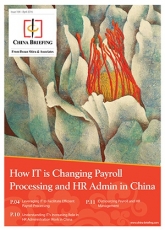Understanding IT’s Increasing Role in HR Administration Work in China
By Helen Kong
Editors: Qian Zhou & Alexander Chipman Koty
Software platforms are playing an increasingly important role in bridging the information gap between payroll processors and their clients. Those same platforms are now being harnessed to generate and store the various HR administration records that companies need to maintain. These systems are effectively reducing the risk that arises from incomplete or inaccurate HR documentation.
HR documentation in any country tends to be of a similar nature, and in China and the other main emerging economies of Asia, the core documents are the same. The offer letter and employee contract define, in different forms, the detail of the employment relationship between the two parties. The employee handbook further delineates the rules and regulations that the company expects the employee to follow. Additionally, the employee information form captures all the relevant details concerning each employee and ensures that those employees take responsibility for the truthfulness of the information they provide to the company. Other documents relating to positions within the organization, such as job descriptions, also need to be managed.
Once templates have been defined for each of these documents, they can be configured within the payroll processor’s system. Assuming an HR hierarchy is set up and operating for the purposes of employee leave and overtime management, it is a fairly straightforward task to add functionality to manage the onboarding of new employees. The relevant information about prospective incoming employees can be entered into the system directly by the recruiting manager. If the hiring manager decides that a candidate is to be hired, that person can update details about monthly salary, starting date, etc. in the system. Once approved by the HR manager, an offer letter can be automatically
generated from the system.
![]() RELATED: Information Technology-based Solutions from Dezan Shira & Associates
RELATED: Information Technology-based Solutions from Dezan Shira & Associates
Assuming the candidate accepts the offer, the employment contract may be generated in the same way and signed by both parties. The employee information form is then filled out by the incoming employee inside the system, printed out, and signed by that employee.
IT systems are also able to facilitate the uploading of all HR documentation back into the system after they have been physically signed/stamped by employee and employer. Reports can be produced on a regular basis highlighting any particular employees for which specific scanned documents are missing, and therefore warn the company about any potential problems that may be developing. At this point, it is worthwhile to note that in China, as with most Asian countries, the original employment contract has much greater legal value than a scanned document. It is therefore still critical for companies to ensure they are in control of the original versions as well. Nevertheless, easily-accessible scanned copies are useful and allow companies to put the physical documents into “deep storage” at minimal expense.
Ultimately, HR administration work in most countries across Asia cannot avoid an element of manual, physical work. Important documentation still requires physical signatures and company stamps. It is likely to be years before digital signatures on the most fundamental documentation become acceptable. However, the sea change has already commenced: IT is allowing headquarters to take closer control of their local HR teams across Asia.
 This article is an excerpt from the April issue of China Briefing Magazine, titled “How IT is Changing Payroll Processing and HR Admin in China.” In this issue of China Briefing, we examine how foreign multinationals can take better advantage of IT in the gathering, storing, and analyzing of HR information in China. We look at how IT can help foreign companies navigate China’s nuanced payroll processing regulations, explain how software platforms are becoming essential for HR, and finally answer questions on the efficacy of outsourcing payroll and HR in China. This article is an excerpt from the April issue of China Briefing Magazine, titled “How IT is Changing Payroll Processing and HR Admin in China.” In this issue of China Briefing, we examine how foreign multinationals can take better advantage of IT in the gathering, storing, and analyzing of HR information in China. We look at how IT can help foreign companies navigate China’s nuanced payroll processing regulations, explain how software platforms are becoming essential for HR, and finally answer questions on the efficacy of outsourcing payroll and HR in China. |

 Human Resources and Payroll in China 2015
Human Resources and Payroll in China 2015
This edition of Human Resources and Payroll in China, updated for 2015, provides a firm understanding of China’s laws and regulations related to human resources and payroll management – essential information for foreign investors looking to establish or already running a foreign-invested entity in China, local managers, and HR professionals needing to explain complex points of China’s labor policies.
 Labor Dispute Management in China
Labor Dispute Management in China
In this issue of China Briefing, we discuss how best to manage HR disputes in China. We begin by highlighting how China’s labor arbitration process – and its legal system in general – widely differs from the West, and then detail the labor disputes that foreign entities are likely to encounter when restructuring their China business. We conclude with a special feature from Business Advisory Manager Allan Xu, who explains the risks and procedures for terminating senior management in China.
 Internet Challenges & Solutions When Doing Business in China
Internet Challenges & Solutions When Doing Business in China
In this special edition of China Briefing magazine, we highlight how and why foreign companies will be negatively affected by China’s internet, and provide methods to help solve these problems. We discuss ISP selection, internet connection types, CDNs and VPNs, and internal control systems. Finally, we examine the importance of network security in China and how it can help augment a company’s internet connection.
- Previous Article Hiring Disabled Workers in China: Incentives and Challenges
- Next Article Case Study: Labor Contract Compliance in China




























